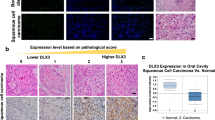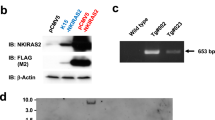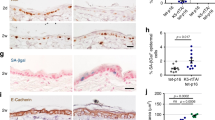Abstract
Rac1 has a role in proliferation and survival of tumor cells in vitro. The exact effects of Rac1 on growth, apoptosis and corresponding signaling pathways during tumorigenesis in vivo, however, have not been explored yet. Using mice with a keratinocyte-restricted deletion of the Rac1 gene, we found that Rac1 is essential for DMBA/TPA-induced skin tumor formation. This corresponded to a decreased keratinocyte hyperproliferation, although apoptosis was not detectably altered. Activated Rac1 promoted Erk-dependent hyperproliferation by Pak1-mediated Mek activation independent of Mek1 phosporylation at serine 298. Rac1 was furthermore required for Pak2-dependent hyperactivation of Akt, which under in vivo condition was restricted to the suprabasal cell layers corresponding to a suprabasal-specific expression of Pak2. It is surprising that none of these signaling pathways was altered in untreated Rac1-deficient skin, indicating a hyperproliferation-specific function of Rac1 in vivo. These data suggest that blocking of Rac1 function might allow tumor-specific growth repression, as Rac1 is not required for normal growth and growth signaling controlling pathways in skin in vivo.
This is a preview of subscription content, access via your institution
Access options
Subscribe to this journal
Receive 50 print issues and online access
$259.00 per year
only $5.18 per issue
Buy this article
- Purchase on Springer Link
- Instant access to full article PDF
Prices may be subject to local taxes which are calculated during checkout








Similar content being viewed by others
References
Benitah SA, Frye M, Glogauer M, Watt FM . (2005). Stem cell depletion through epidermal deletion of Rac1. Science 309: 933–935.
Castilho RM, Squarize CH, Patel V, Millar SE, Zheng Y, Molinolo A et al. (2007). Requirement of Rac1 distinguishes follicular from interfollicular epithelial stem cells. Oncogene 26: 5078–5085.
Chrostek A, Wu X, Quondamatteo F, Hu R, Sanecka A, Jay S et al. (2006). Rac1 is crucial for hair follicle integrity but is not essential for maintenance of the epidermis. Mol Cell Biol 26: 6957–6970.
Eblen ST, Slack JK, Weber MJ, Catling AD . (2002). Rac-PAK signaling stimulates extracellular signal-regulated kinase (ERK) activation by regulating formation of MEK1-ERK complexes. Mol Cell Biol 22: 6023–6033.
Espina C, Céspedes MV, García-Cabezas MA, Gómez del Pulgar MT, Boluda A, Oroz LG et al. (2008). A critical role for Rac1 in tumor progression of human colorectal adenocarcinoma cells. Am J Pathol 172: 156–166.
Hawkins PT, Eguinoa A, Qiu RG, Stokoe D, Cooke FT, Walters R et al. 1995. PDGF stimulates an increase in GTP-Rac via activation of phosphoinositide 3-kinase. Curr Biol 5: 393–403.
Higuchi M, Onishi K, Kikuchi C, Gotoh Y . (2008). Scaffolding function of PAK in the PDK1-Akt pathway. Nat Cell Biol 10: 1356–1364.
Hirsch E, Barberis L, Brancaccio M, Azzolino O, Xu D, Kyriakis JM et al. (2002). Defective Rac-mediated proliferation and survival after targeted mutation of the beta1 integrin cytodomain. J Cell Biol 157: 481–492.
Karlsson R, Pedersen ED, Wang Z, Brakebusch C . (2009). Rho GTPase function in tumorigenesis. Biochim Biophys Acta 1796: 91–98.
Keely PJ, Westwick JK, Whitehead IP, Der CJ, Parise LV . (1997). Cdc42 and Rac1 induce integrin-mediated cell motility and invasiveness through PI(3)K. Nature 390: 632–636.
King AJ, Sun H, Diaz B, Barnard D, Miao W, Bagrodia S et al. (1998). The protein kinase Pak3 positively regulates Raf-1 activity through phosphorylation of serine 338. Nature 396: 180–183.
Kissil JL, Walmsley MJ, Hanlon L, Haigis KM, Bender Kim CF, Sweet-Cordero A et al. (2007). Requirement for Rac1 in a K-ras induced lung cancer in the mouse. Cancer Res 67: 8089–8094.
Malliri A, van der Kammen RA, Clark K, van der Valk M, Michiels F, Collard JG . (2002). Mice deficient in the Rac activator Tiam1 are resistant to Ras-induced skin tumours. Nature 417: 867–871.
Maruta H, He H, Nheu T . (2002). Interfering with Ras signaling using membrane-permeable peptides or drugs. Methods Mol Biol 189: 75–85.
Mertens AE, Rygiel TP, Olivo C, van der Kammen R, Collard JG . (2005). The Rac activator Tiam1 controls tight junction biogenesis in keratinocytes through binding to and activation of the Par polarity complex. J Cell Biol 170: 1029–1037.
Perez-Losada J, Balmain A . (2003). Stem-cell hierarchy in skin cancer. Nat Rev Cancer 3: 434–443.
Sahai E, Marshall CJ . (2002). RHO-GTPases and cancer. Nat Rev Cancer 2: 133–142.
Segrelles C, Ruiz S, Perez P, Murga C, Santos M, Budunova IV et al. (2002). Functional roles of Akt signaling in mouse skin tumorigenesis. Oncogene 21: 53–64.
Skeen JE, Bhaskar PT, Chen CC, Chen WS, Peng XD, Nogueira V et al. (2006). Akt deficiency impairs normal cell proliferation and suppresses oncogenesis in a p53-independent and mTORC1-dependent manner. Cancer Cell 10: 269–280.
Slack-Davis JK, Eblen ST, Zecevic M, Boerner SA, Tarcsafalvi A, Diaz HB et al. (2003). PAK1 phosphorylation of MEK1 regulates fibronectin-stimulated MAPK activation. J Cell Biol 162: 281–291.
Sundberg-Smith LJ, Doherty JT, Mack CP, Taylor JM . (2005). Adhesion stimulates direct PAK1/ERK2 association and leads to ERK-dependent PAK1 Thr212 phosphorylation. J Biol Chem 280: 2055–2064.
Thomas EK, Cancelas JA, Chae HD, Cox AD, Keller PJ, Perrotti D et al. (2007). Rac guanosine triphosphatases represent integrating molecular therapeutic targets for BCR-ABL-induced myeloproliferative disease. Cancer Cell 12: 467–478.
Tscharntke M, Pofahl R, Chrostek-Grashoff A, Smyth N, Niessen C, Niemann C et al. (2007). Impaired epidermal wound healing in vivo upon inhibition or deletion of Rac1. J Cell Sci 120: 1480–1490.
Xia Z, Dickens M, Raingeaud J, Davis RJ, Greenberg ME . (1995). Opposing effects of ERK and JNK-p38 MAP kinases on apoptosis. Science 270: 1326–1331.
Acknowledgements
We thank Dr Peter Staller and Dr Chris Marshall for advice, Dr Anders Lund for providing the plasmids, Volkan Turan for excellent technical help, Anna Fossum for FACS, and Sahar Abelechian and Anita Friismose for help with mouse handling. This work was supported by the Danish Cancer Foundation and the Novo Nordisk Foundation.
Author information
Authors and Affiliations
Corresponding author
Ethics declarations
Competing interests
The authors declare no conflict of interest.
Additional information
Supplementary Information accompanies the paper on the Oncogene website
Supplementary information
Rights and permissions
About this article
Cite this article
Wang, Z., Pedersen, E., Basse, A. et al. Rac1 is crucial for Ras-dependent skin tumor formation by controlling Pak1-Mek-Erk hyperactivation and hyperproliferation in vivo. Oncogene 29, 3362–3373 (2010). https://doi.org/10.1038/onc.2010.95
Received:
Revised:
Accepted:
Published:
Issue Date:
DOI: https://doi.org/10.1038/onc.2010.95
Keywords
This article is cited by
-
TNFAIP8 promotes AML chemoresistance by activating ERK signaling pathway through interaction with Rac1
Journal of Experimental & Clinical Cancer Research (2020)
-
Vav2 pharmaco-mimetic mice reveal the therapeutic value and caveats of the catalytic inactivation of a Rho exchange factor
Oncogene (2020)
-
Rho GTPases in cancer: friend or foe?
Oncogene (2019)
-
Loss of RhoA promotes skin tumor formation and invasion by upregulation of RhoB
Oncogene (2018)
-
IGF1R signaling drives antiestrogen resistance through PAK2/PIX activation in luminal breast cancer
Oncogene (2018)



